The Cost of Employee Turnover for U.S. Companies is Sky-High. Here's How to Increase Retention and Cut Turnover Spending.
Last Updated Nov 4, 2025

Employee turnover hams morale and drains budgets. Estimates show that turnover can cost anywhere from half to two times an employee’s annual salary. For a 100-person company with average pay of $50,000, that could mean up to $2.6 million in annual replacement costs.
That’s not a small dent—it’s a full-on budget crater.
And the impact goes deeper than dollars. High turnover disrupts team dynamics, slows down productivity, and piles pressure on HR teams already managing too much. And when exits outpace hires, even the best people strategies can fall apart.
It’s time to get proactive. Understand the full financial and cultural cost of employee turnover—and what you can do about it.
Uncover the benefits of retention-driven tactics like wellness programs, career development, and flexible work. Elevate your strategy and build a workplace that keeps great talent around.
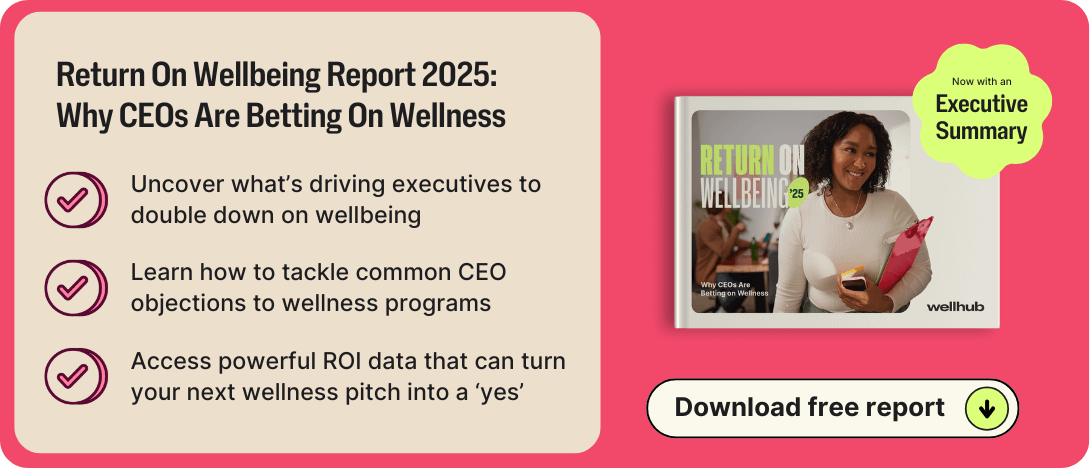
What You'll Learn
- Employee turnover is expensive, often costing between 50% and 200% of an employee’s annual salary, with U.S. businesses losing around $1 trillion each year.
- Direct costs like recruiting, onboarding, and severance combine with indirect costs such as lost productivity, weakened morale, and reduced institutional knowledge.
- Retention strategies—wellbeing programs, career development, and flexible work—consistently deliver high ROI, such as up to 425% for childcare benefits.
- Burnout is a major turnover driver, but wellness investments and flexible policies reduce stress, increase engagement, and cut resignations.
- Companies with strong retention programs enjoy higher profitability, stronger culture, and resilience during change, making retention a long-term business advantage.
What Is Employee Turnover? Why Does it Matter?
Employee turnover is the rate of employees leaving an organization during a specific period. It includes voluntary exits — which happen when employees resign — and involuntary exits, such as layoffs or terminations.
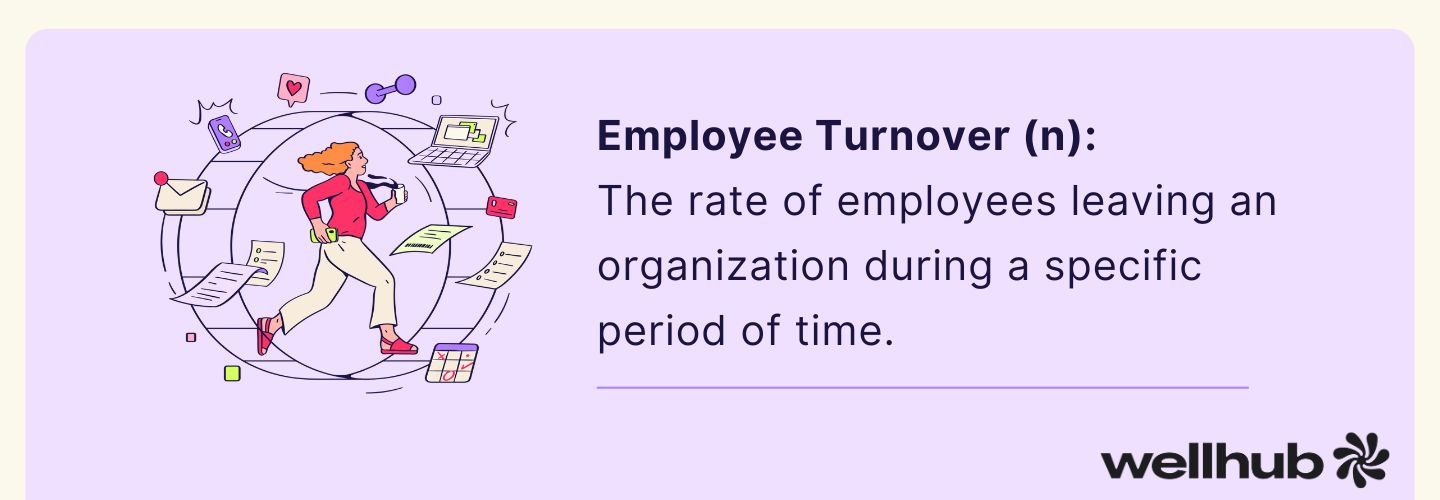
In addition to disrupting projects, over the long term employee turnover disrupts team stability, inflates recruitment costs, and weakens the overall health of the workforce.
To anticipate challenges arising from employee turnover, HR leaders should track turnover and understand the factors behind it. This helps them anticipate challenges, plan strategically, and prevent issues before they undermine performance. (More on the nuts and bolts of how to do this later.)
Employee Turnover vs. Employee Retention
Employee turnover and retention are two sides of the same coin, but they play different purposes in workforce planning:
- Turnover is reactive. This shows how many people leave, but also when they do and under what circumstances. Rising turnover is often a warning sign of deeper problems affecting morale, productivity, or culture.
- Retention is proactive. This is an organization's ability to keep its employees for a sustained period. It reflects an organization’s ability to create an environment where employees choose to stay. Strong retention strategies reduce hidden costs and signal organizational resilience.
HR leaders need to strike a balance between these two metrics. To identify areas where problems exist, they can analyze turnover rates, which reveal where issues lie. Meanwhile, retention strategies offer solutions to address these problems and foster long-term workforce stability.
How Much Does Employee Turnover Cost, On Average?
The average cost of employee turnover in the U.S. is typically between 50% and two times an employee’s annual salary, depending on the role, experience level, and industry. Most current HR sources estimate that replacing an individual worker can cost from half their annual salary (for entry-level, hourly roles) to upwards of 213% of salary (for C-suite executives). On an aggregate level, annual turnover is estimated to cost U.S. businesses roughly $1 trillion per year.
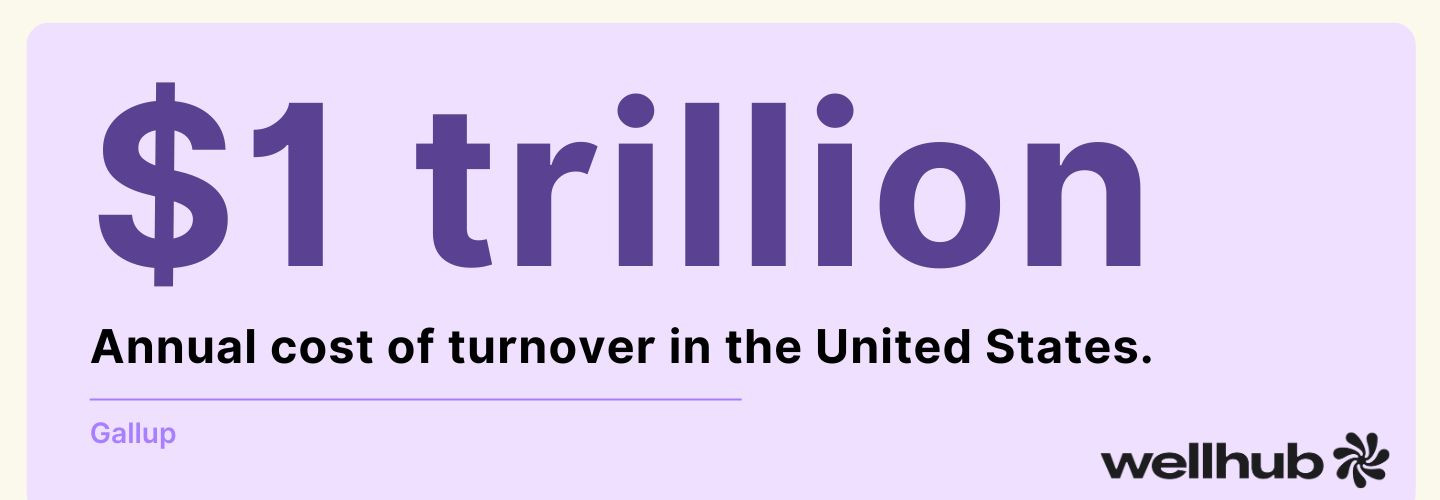
Cost Benchmarks by Employee Type
- Entry-level/non-skilled: 30–50% of annual salary
- Hourly/service/production: 40–70% of annual salary
- Clerical/administrative: 50–80% of annual salary
- Skilled hourly/professional: 75–125% of annual salary
- Technical/supervisor: 100–150% of annual salary
- Executive/C-suite: Up to 213% of annual salary
The Real Cost of Employee Turnover in the U.S. (Industry Numbers)
Employee turnover carries significant direct and indirect costs for employers. The table below summarizes average total turnover costs per employee across various U.S. industries in 2024, including recruiting, training, lost productivity, and other indirect costs. It also shows these costs as a percentage of payroll (where data is available) and provides a breakdown by job level when possible. All figures are in U.S. dollars and percentages.
| Industry | Avg. Turnover Cost (USD per employee) | Cost as % of Payroll | Breakdown by Job Level |
|---|---|---|---|
| Healthcare | ~$56,300 per nurse (hospital average) | >5% of total hospital budget | Registered Nurse: ~$56k Physician: $500k–$1M (higher for physicians due to lost revenue) |
| Retail | ~$2,686 per employee (average) | ~10–25% of annual payroll | Entry-level: ~50% of salary (≈$1.5k for hourly roles) Mid-level: ~125% Executive: ~200% |
| Hospitality (Restaurants/Hotels) | ~$9,932 per employee (average total cost) | ~10–25% of annual payroll | Front of House — $1,056 Back of House— $1,491 Manager: $2,611 (direct costs) – indirect costs drive total higher ($9,900) |
| Manufacturing | $10,000–$40,000 per worker (skilled roles) | N/A (varies by firm) | Skilled frontline worker: $10k–$40k replacement cost; higher for specialized or senior positions (proportionally more) |
| Financial Services (Banking) | ~$20,000 per employee (avg. net cost) | Estimated ~20–30% | ~150% of annual salary per average employee 200–250% of salary for managers or sales roles |
Types of Turnover Costs
Employee turnover is far more expensive than many executives realize. Replacing leaders and managers can cost about 200% of their salary, while technical roles average 80% and frontline employees 40%, according to Gallup.
These replacement costs add up quickly because there's a lot that goes into that figure. It's not just lost productivity (though that's part of it). There are a lot of expenses and losses that go into determining the true cost of turnover.
Direct Costs
Direct costs are measurable expenses linked to an employee's departure and replacement. They include:
- Recruitment and hiring expenses: Advertising jobs, agency fees, applicant tracking systems, background checks, and the time managers and HR staff spend screening and interviewing all add up.
- Onboarding and training: Even with digital onboarding systems, onboarding a new hire requires orientation sessions, training materials, manager supervision, and mentoring. Productivity losses during this learning period are significant.
- Severance and exit costs: Accrued vacation payouts, severance packages, unemployment insurance claims, and time spent on exit interviews and paperwork represent real financial outflows.
- Loss of productivity during vacancy: When a role remains open, colleagues or temporary staff must cover the workload. This can lead to overtime pay and even temporary worker contracts.
Indirect Costs
Indirect costs are expenses that aren’t directly linked to a specific product or project. Examples include:
- Decreased morale and team dynamics: When turnover is high, remaining employees can feel overburdened, disengaged, or uncertain about their own future. As a result, they may take more sick leave, arrive late, or appear disengaged, leading to increased errors, reduced team engagement, and overall lower performance.
- Lost institutional knowledge: Departing employees often take with them years of expertise and informal knowledge. This loss can stall projects, disrupt client relationships, and force teams to reinvent the wheel on processes that used to run smoothly. In some cases, it can take months or even years for replacements to develop the same depth of understanding.
- Impact on company culture: Frequent departures weaken team cohesion, hinder trust, and may damage the company’s reputation as a great place to work.
Add up direct and indirect costs, and employee turnover stops being a background HR issue. It becomes one of the biggest hidden risks to a company’s bottom line.
How to Calculate Turnover Costs
To understand the consequences of turnover, you must first calculate turnover costs. Follow these steps to get started.
Step 1: Calculate Your Turnover Rate
The standard formula is:
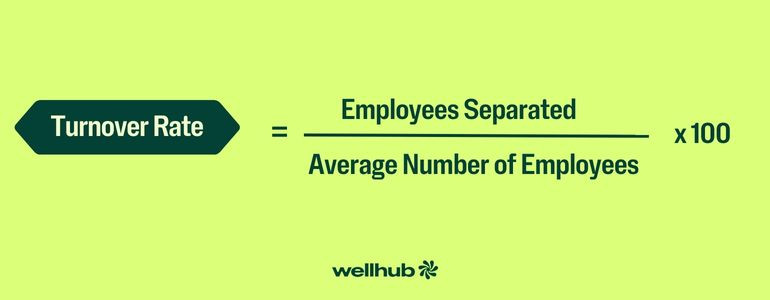
For example, if a 100-person company loses 15 employees in a year, the turnover rate is:
(15 ÷ 100) × 100 = 15%
This rate is the foundation for measuring financial impact.
Step 2: Determine the Average Cost of Departure
This is the most complicated step, as it requires adding both direct and indirect expenses for each employee’s departure. Remember to include the following cost components in the calculation:
- Hiring costs: Job advertising, recruiter fees, background checks, and the time managers and human resources staff spend screening and interviewing candidates.
- Onboarding and development costs: Time spent training new hires and developing their skills. This includes training materials and sessions, orientation materials, and the productivity dip while new hires ramp up.
- Lost productivity: The time and productivity lost while a role is vacant and during a new employee’s ramp-up period.
- Lost expertise: Institutional knowledge, client relationships, and specialized skills that departing employees take with them.
- Exit costs: Severance packages, administrative time spent on offboarding and exit interviews, and unemployment insurance.
Step 3: Combine for Conmpany's Total Turnover Cost
Once you’ve determined the turnover rate and average cost per departure, you can calculate the total cost:

Here’s an example: If 15 employees left a 100-person company and the average cost of departure is $50,000, 15 × $50,000 = $750,000 is the annual turnover cost.
Why It's Critical for Businesses to Invest in Employee Retention
Every business will have some turnover, but much of it is avoidable: 42% of employees who quit say their company could have prevented their departure—but no one had a proactive conversation with them. In fact, 45% say no manager even asked how they were doing in the months before they left.
Here's why reducing those numbers should be a high-priority for every businesses.
Employee Retention Is a High-ROI Investment
Retention protects productivity, team morale, institutional knowledge—and your bottom line.
Research shows ath effective retention strategies consistently deliver a high return on investment. For example, childcare benefits offer a 425% ROI, according to research from Boston Consulting Group. This kind of three-figure ROI is possible because turnover is crazy expensive. Here’s how it adds up:
- The cost of losing a single employee can equal 50% to 200% of their annual salary.
- Burnout-related turnover consumes 15% to 20% of payroll budgets each year.
Losing great people? Uncover the top reasons employees leave—and what to do to keep them.
Retention Strategies Fuel Long-Term Performance
When retention is high:
- Teams collaborate more smoothly.
- Institutional knowledge sticks around.
- Managers can focus on development instead of backfilling.
And the outcomes are measurable:
- Business units with engaged employees report 23% higher profitability.
- Companies with effective retention strategies are three times more likely to engage and retain workers.
Even recruitment gets easier. Why? High retention improves your employer brand, and jobseekers are 86% more likely to apply if your company has positive reviews.
Burnout Is Draining Productivity and Driving Resignations
Burnout isn’t just a vibe—it’s a business risk. Burned-out employees are:
- Two times more likely to be actively job hunting
- 63% more likely to miss work
- 13% less confident in their job performance
And that stress spreads. When one person is overwhelmed, others pick up the slack—until they, too, start to burn out.
The solution? Proactive retention strategies that include wellness benefits, mental health support, and flexible policies. Even in traditionally “hard-to-engage” sectors, like mining or manufacturing, mental health investments deliver industry-leading ROI.
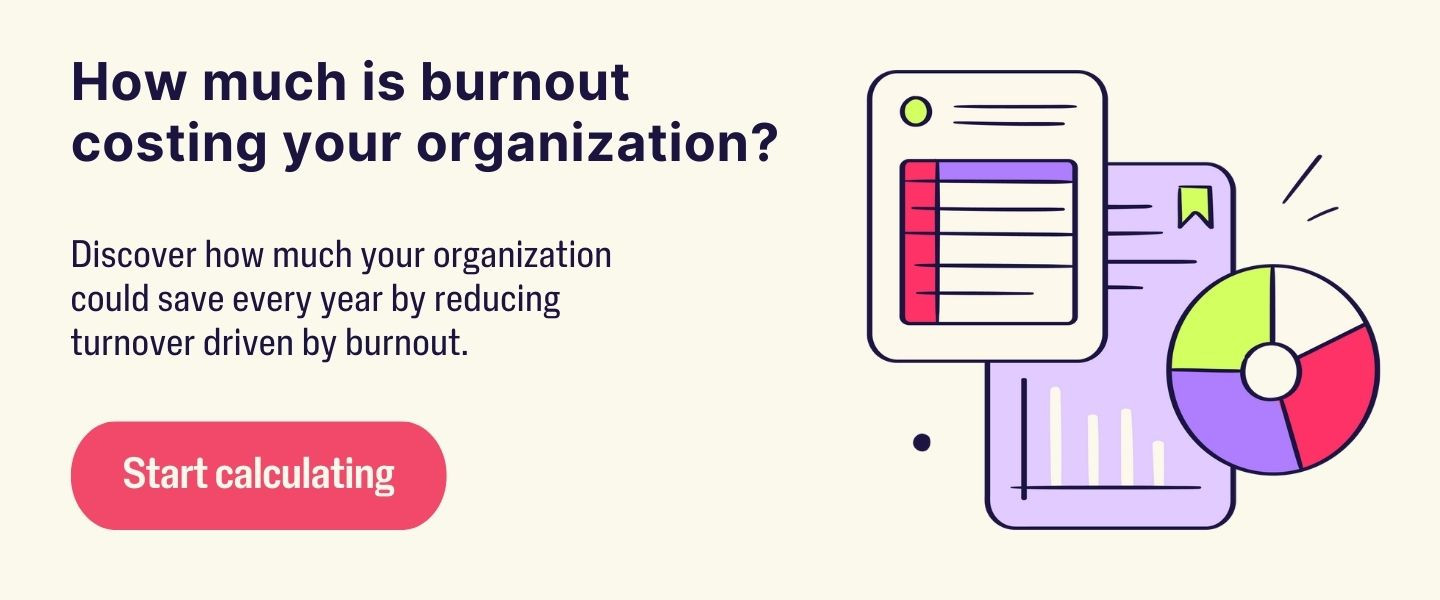
Retention Builds Resilience
Retention helps you future-proof your workforce. Companies with strong retention:
- Bounce back faster after layoffs or reorgs
- Develop stronger internal leadership pipelines
- Maintain trust through change
That's a stability multiplier. And in an uncertain world, that’s priceless.
Reduce Turnover Costs With These 8 Retention Strategies
To reduce turnover rates and associated costs, you must create an environment that promotes employee success and minimizes burnout. You can achieve this by focusing on three key areas of high impact.
- Implement Wellness Programs as Benefits
Employee wellbeing programs are structured initiatives designed to strengthen physical, mental, emotional, and financial wellbeing while reducing workplace stressors. Typical offerings include fitness memberships, sleep and mindfulness tools, nutritional resources, and stress management support.
By providing wellness programs, companies demonstrate genuine care for their workforce. They also get a measurable payoff. Employees who strongly agree that their company genuinely cares about their overall wellbeing — according to a 2024 Gallup survey — are:
- 4.4 times more likely to be engaged at work
- 7 times more likely to say they'd recommend their workplace as a great place to work
- 73% less likely to feel burnout “very often or always”
- 53% less likely to be actively seeking a new job
- 50% more likely to report thriving in life overall
The message is clear: wellbeing programs don’t just make employees feel supported — they directly improve retention, engagement, and loyalty. It’s no surprise that the same Gallup poll also reports 23% of chief human resources officers rank wellbeing as a top organizational priority.
- Offer Career Development and Professional Growth Opportunities
When companies invest in employee development, workers feel valued and motivated to add value. Career pathways, mentorship programs, and upskilling opportunities show staff that they can advance and build long-term careers within the organization.
This is especially true for younger generations, who consistently rank career growth and learning opportunities above salary as a reason to stay. A survey of over 1,100 Gen Z U.S.-based workers found that 83% consider themselves job hoppers, according to a 2024 ResumeLab survey. This isn't because they lack commitment. Rather, they believe their rapid job-changing is justified since they're actively seeking new challenges and environments that align with their values and ambitions.
To capture these workers' preferences, HR leaders should use retention strategies that prioritize growth and learning.
- Provide Flexible Work Arrangements
Since the pandemic, flexible work arrangements have shifted from “nice-to-haves” to “must-haves.” Employees now expect options such as remote work, hybrid schedules, and adjustable hours. As such, organizations should provide flexible work arrangements to attract and retain workers.
A survey of 21,543 U.S. employees revealed that 61% of workers whose jobs could be done remotely preferred a hybrid schedule, and an additional 28% would prefer to be fully remote, according to a 2024 Gallup study. Engagement levels were also higher among flexible workers: 37% of fully remote and 36% of hybrid employees reported being engaged, compared with just 30% of on-site employees.
Additional research reinforces the benefits of retaining employees through flexible work arrangements. A study on working-from-home professionals found that resignations fell by 33% among workers who transitioned from full-time to hybrid work arrangements, according to Stanford economist Nicholas Bloom's 2024 research. Non-managers, women, and employees with long commutes were especially less likely to quit when office attendance was cut to three days a week.
For employers, the message is clear: meeting employee expectations around flexibility reduces burnout, supports work-life wellness, and builds the trust and loyalty that keep top talent long term.
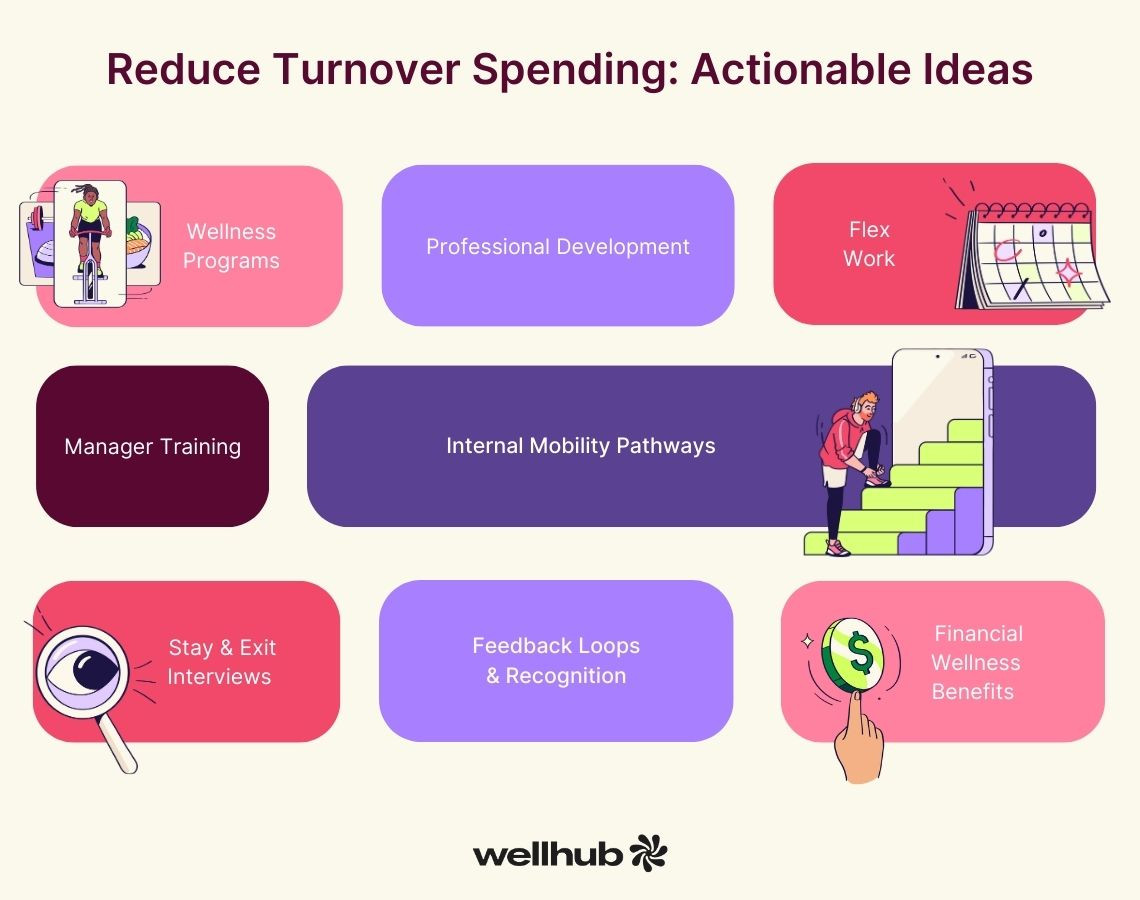
- Improve Manager Training and Accountability
Employees don't leave jobs—they leave managers.
And the data backs that up. Remember how 42% of employees who quit in the past year said their organization could have prevented it, and 45% said no one discussed their job satisfaction or future with them in the three months before they left?
That’s a powerful call to action. Managers play a pivotal role in employee experience. They’re responsible not just for performance, but also for morale, clarity, and growth.
To reduce preventable turnover, HR leaders must ensure managers are trained in:
- Empathetic leadership
- Career conversations
- Recognition practices
- Early intervention for burnout
Equip your managers to lead people—not just projects. Consider adding "stay interviews" and check-ins to their KPIs. When managers proactively engage with their team members, retention rises—and trust deepens.
Top talent won’t wait around.Get ahead of 2026’s retention challenges with data-driven solutions.
- Normalize Feedback Loops and Recognition
Frequent feedback and recognition build a culture of trust and belonging. And when employees feel seen, they’re more likely to stay.
Employees who are regularly recognized are up to 10 times more likely to feel like they belong at their company, according to joint research from Workhuman and Gallup. And belonging is one of the strongest predictors of retention.
Here’s how to reinforce recognition:
- Encourage managers to give weekly praise, not just annual reviews.
- Celebrate milestones—both personal and professional.
- Use peer-to-peer recognition platforms to spread appreciation across teams.
- Make recognition values-aligned. Celebrate behaviors that reflect your company culture.
This isn’t just feel-good fluff. Recognition reinforces purpose. And purpose fuels performance—and loyalty.
- Conduct Stay Interviews and Exit Surveys
Most companies only learn why employees leave after it’s too late. But what if you could spot the signs earlier?
Stay interviews are proactive conversations with current employees focused on one thing: discovering what would make them stay.
Here’s what to ask:
- What do you look forward to at work?
- What talents are we not using?
- What would make you consider leaving?
- What could I do to better support you?
Unlike performance reviews, stay interviews aren’t about evaluating employees—they’re about listening. And they give HR critical insight into patterns of disengagement before they become resignations.
Exit interviews, when conducted consistently, can also help you surface systemic issues like toxic culture, poor management, or career stagnation that may be affecting retention more broadly.
Not all turnover is the same.Find out which types matter most—and how to manage them strategically.
- Expand Access to Financial Wellness Benefits
Turnover isn't just emotional—it’s financial. And so is the stress driving it.
Sixty-eight of workers say their financial situation prevents them from investing in their wellbeing, and 66% say it distracts them from work.
Supporting financial wellbeing is one of the most overlooked—but effective—ways to retain employees.
Here’s what to offer:
- Access to financial education tools
- Student loan repayment assistance
- Emergency savings programs
- Transparent pay equity audits
- Retirement planning resources
These benefits help employees feel more secure in their roles—and more committed to the employer supporting their goals.
When people feel financially empowered, they’re more likely to stay engaged, loyal, and focused.
- Build Internal Mobility Pathways
Career growth doesn’t have to mean leaving your company.
But if employees don’t see a clear internal path, they’ll find one elsewhere.
Invest in inboarding, job rotation programs, and role shadowing to help employees explore new directions without having to start over at another organization. Highlight internal hires regularly and share stories that illustrate how your company promotes from within.
Here’s what else helps:
- Make internal job postings transparent and accessible.
- Train managers to advocate for internal mobility, not just guard talent.
- Add career pathing to performance conversations—not just annual reviews.
Employees with access to professional development tools report significantly higher engagement and satisfaction levels, and are far less likely to leave in the next 12 months.
Mobility is retention in disguise. When people can grow with you, they won’t outgrow you.
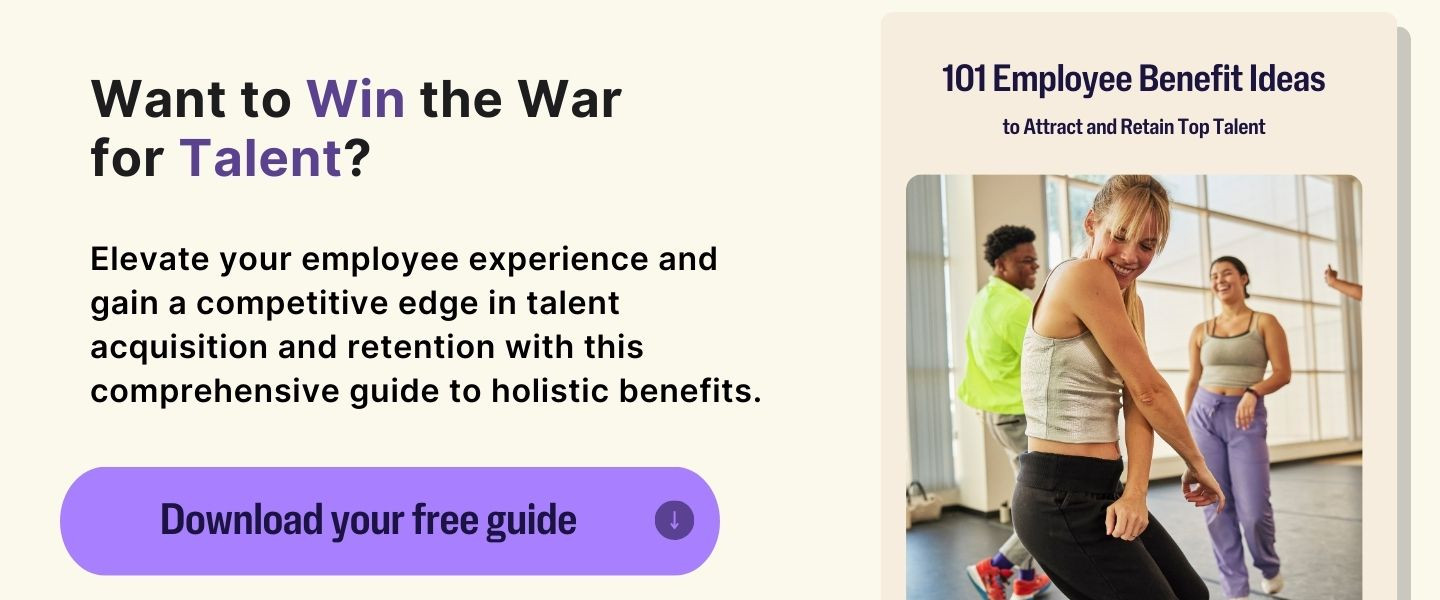
How Wellbeing Programs Reduce Employee Turnover and Turnover Spending
Wellbeing programs are one of the most effective tools to reduce turnover, keep your high performers, and lower the costs that come with attrition.
To break it down:
- 98% of HR leaders say their wellbeing program reduces turnover.
- 66% of CEOs believe their employees would consider leaving if their company didn't prioritize wellbeing.
- 83% of employees say they would consider leaving a company that doesn’t prioritize their wellbeing.
- 73% of CEOs say their wellbeing program directly improves talent retention.
Let's dig into why.
Wellbeing Programs Are a Retention Engine
The numbers don’t lie — when you support wellbeing, employees stay longer, perform better, and cost less to retain.
Here's what the data shows:
| Key Retention Indicator | With Wellbeing Program | Without Wellbeing Program |
|---|---|---|
| Employees who say they’re happy at work | 61% | 36% |
| Employees who say HR genuinely cares about them | 79% | 45% |
| Employees who rate their benefits program as top-notch | 70% | 36% |
| Employees who feel fairly compensated | 84% | 61% |
These are the drivers that influence retention. When employees feel supported — emotionally, physically, and financially — they’re far more likely to stay, grow, and refer others to join your team.
The ROI of Wellness Undeniable
This isn’t just about making people feel good. This is about business outcomes:
- 89% of HR leaders say wellbeing programs reduce sick days.
- 87% of HR leaders say their wellbeing program helps employees build resilience.
- 82% of CEOs report a positive ROI from their wellness programs — and 78% report returns over 50%.
And when wellbeing becomes part of your culture, the effect compounds: Companies with effective wellbeing strategies are more than three times as likely to engage and retain workers.
Drive Retention With Employee Wellbeing
Employee turnover is one of the most underestimated costs in U.S. businesses. Besides inflating recruitment and training costs, it also leads to hidden productivity losses, weakened morale, burnout, and eroded company culture. To cut down on these costs, HR leaders must drive retention by improving employee wellbeing. This goes hand in hand with efforts to build a strong company culture where employees feel valued and supported.
When employers support workers' emotional health, physical fitness, sleep, and mindfulness practices, workers have more energy to bring commitment to their work. The result? Lower turnover. In fact, companies with Wellhub have seen their retention improve by up to 43%.
Interested? Speak with a Wellhub wellbeing specialist today!

Company healthcare costs drop by up to 35% with Wellhub*
See how we can help you reduce your healthcare spending.
[*] Based on proprietary research comparing healthcare costs of active Wellhub users to non-users.
Category
Share

The Wellhub Editorial Team empowers HR leaders to support worker wellbeing. Our original research, trend analyses, and helpful how-tos provide the tools they need to improve workforce wellness in today's fast-shifting professional landscape.
Subscribe
Our weekly newsletter is your source of education and inspiration to help you create a corporate wellness program that actually matters.
Subscribe
Our weekly newsletter is your source of education and inspiration to help you create a corporate wellness program that actually matters.
You May Also Like

Attrition, Turnover & Retention Differences Explained | Wellhub
Clearly understand the attrition, turnover, retention difference to improve workforce planning, reduce costs, and strengthen your people strategy.

Termination Letter Template: 3-Step HR Risk Guide | Wellhub
Protect every separation with a termination letter template, plus a 3-step HR framework that reduces legal risk, supports dignity, and keeps teams stable.

10 Exit Interview Questions to Ask | Wellhub
Discover the top 10 exit interview questions to ask employees. Gain valuable feedback, identify areas for improvement, and enhance your workplace culture.